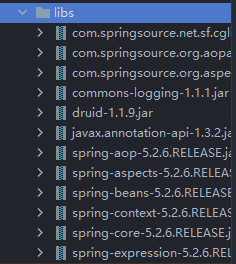AOP 操作(准备)
1、Spring 框架一般都是基于 AspectJ 实现 AOP 操作
(1)什么是 AspectJ
- AspectJ 不是 Spring 组成部分,是独立的 AOP 框架,一般把 AspectJ 和 Spring 框架一起使用,进行 AOP 操作。
2、基于 AspectJ 实现 AOP 操作
(1)基于 xml 配置文件
(2)基于注解方式实现(常用)
3、在项目工程引入 AOP 相关依赖



4、切入点表达式
(1)切入点表达式作用:直到对哪个类里面的哪个方法进行增强。
(2)语法结构:
execution([权限修饰符] [返回值类型] [类全路径] [方法名称] ([参数列表]))
例子:
对 com.tt.stu.dao.BookDao 类里面的 add 进行增强
execution(* com.tt.stu.dao.BookDao.add(…))
* :表示任意权限修饰符
… :表示方法中的参数
对 com.tt.stu.dao.BookDao 类里面的所有方法进行增强
execution(* com.tt.stu.dao.BookDao.(…)*)
对 com.tt.stu.dao 包里面所有类,类里面所有方法进行增强
execution(* com.tt.stu.dao.*.*(…))
AOP 操作(AspectJ 注解)
1、创建类,在类里面定义方法
// 被增强的类
public class User {
public void add() {
System.out.println("add ...");
}
}
2、创建增强类(编写增强的逻辑)
(1)在增强类里面,创建方法,让不同方法代表不同通知类型。
// 增强的类
public class UserProxy {
// 前置通知
public void before() {
System.out.println("before ...");
}
}
3、进行通知的配置
(1)在 spring 配置文件中,开启注解扫描
<?xml version="1.0" encoding="UTF-8"?>
<beans xmlns="http://www.springframework.org/schema/beans"
xmlns:xsi="http://www.w3.org/2001/XMLSchema-instance"
xmlns:context="http://www.springframework.org/schema/context"
xmlns:aop="http://www.springframework.org/schema/aop"
xsi:schemaLocation="http://www.springframework.org/schema/beans http://www.springframework.org/schema/beans/spring-beans.xsd
http://www.springframework.org/schema/context http://www.springframework.org/schema/context/spring-context.xsd
http://www.springframework.org/schema/aop http://www.springframework.org/schema/aop/spring-aop.xsd">
<!--开启注解扫描-->
<context:component-scan base-package="com.tt.stu.spring5.aopanno"></context:component-scan>
</beans>
(2)使用注解创建 User 和 UserProxy 对象
在类中增加注解
@Component
public class User {
// ...
}
// -------
@Component
public class UserProxy {
// ...
}
(3)在增强类上面添加注解 @Aspect
在增强类,即 UserProxy 上,再添加注解。
@Component
@Aspect // 生成代理对象
public class UserProxy {
// ...
}
(4)在 spring 配置文件中开启生成代理对象
在配置文件中增加配置
<!--开启 Aspect 生成代理对象-->
<aop:aspectj-autoproxy></aop:aspectj-autoproxy>
4、配置不同类型的通知
(1)在增强类的里面,在作为通知方法上添加通知类型注解,使用切入点表达式配置。
// 增强的类
@Component
@Aspect
public class UserProxy {
// @Before 注解表示作为前置通知
@Before(value = "execution(* com.tt.stu.spring5.aopanno.User.add(..))")
public void before() {
System.out.println("before ...");
}
}
5、使用
public class TestAop {
@Test
public void testAopAnno() {
ApplicationContext context = new ClassPathXmlApplicationContext("bean1.xml");
// id 默认为 类名,首字母变为小写
User user = context.getBean("user", User.class);
user.add();
}
}
控制台打印结果如下:
before ...
add ...
我们再看看其他的注解怎么使用,以及执行的时机,我们在 Proxy 中添加如下代码
// 增强的类
@Component
@Aspect // 生成代理对象
public class UserProxy {
// 前置通知
// @Before 注解表示前置通知
@Before(value = "execution(* com.tt.stu.spring5.aopanno.User.add(..))")
public void before() {
System.out.println("before ...");
}
// 最终通知
// @After 注解表示最终通知,有没有异常都会通知
@AfterReturning(value = "execution(* com.tt.stu.spring5.aopanno.User.add(..))")
public void afterReturning() {
System.out.println("afterReturning ...");
}
// 异常通知
// @AfterThrowing 注解表示后置通知
@AfterThrowing(value = "execution(* com.tt.stu.spring5.aopanno.User.add(..))")
public void afterThrowing() {
System.out.println("afterThrowing ...");
}
// 后置通知
// @AfterReturning 注解表示后置通知
@After(value = "execution(* com.tt.stu.spring5.aopanno.User.add(..))")
public void after() {
System.out.println("after ...");
}
// 环绕通知
// @Around 注解表示环绕通知
@Around(value = "execution(* com.tt.stu.spring5.aopanno.User.add(..))")
public void around(ProceedingJoinPoint proceedingJoinPoint) throws Throwable {
System.out.println("环绕之前 ...");
// 被增强的方法执行
proceedingJoinPoint.proceed();
System.out.println("环绕之后 ... ");
}
}
调用测试方法,控制台输出结果:
环绕之前 ...
before ...
add ...
环绕之后 ...
after ...
afterReturning ...
然后我们在被增强的方法中,增加一个异常,看看输出结果
public void add() {
int a = 10 / 0; // 增加异常
System.out.println("add ...");
}
调用测试方法,控制台输出结果:
环绕之前 ...
before ...
after ...
afterThrowing ...
java.lang.ArithmeticException: / by zero
...
可以发现,少了 add 方法,环绕之后以及 afterReturning ,多了 afterThrowing。
6、AspectJ 注解(细节问题)
(1)相同切入点抽取
我们刚刚会发现,每一个通知方法前面我们都用了一模一样的切入点表达式,即
(value = "execution(* com.tt.stu.spring5.aopanno.User.add(..))")
我们可以将这些相同的切入点抽取出来,使代码更简洁
方法:我们在类中添加如下方法,并且使用 @Pointcut 注解。
public class UserProxy {
// 相同切入点抽取
@Pointcut(value = "execution(* com.tt.stu.spring5.aopanno.User.add(..))")
public void pointDemo() {
}
@Before(value = "pointDemo()") // 调用方法
public void before() {
System.out.println("before ...");
}
// ...
}
这样我们可以把所有需要用到这个的切点,通过调用方法获取。
(2)有多个增强类对同一个方法进行增强,设置增强类的优先级,即谁先执行,谁后执行。
a. 在增强类上面添加注解 @Order (数字类型值),数值类型值越小,优先级越高。
我们对 UserProxy 设置为 3,对另一个增强类设置为 1,观察一下输出变化。
@Component
@Aspect // 生成代理对象
@Order(3) // 增加 Order = 3
public class UserProxy { ... }
@Component
@Aspect
@Order(1) // 设置为 1,比 UserProxy 小,优先级更高
public class PersonProxy {
@Before(value = "execution(* com.tt.stu.spring5.aopanno.User.add(..))")
public void before() {
System.out.println("Person before ..");
}
}
调用测试方法,控制台输出结果:
Person before ..
环绕之前 ...
before ...
add ...
环绕之后 ...
after ...
afterReturning ...
在最前面多了 PersonProxy 里面的 before 方法
我们再调换一下它们的优先级,结果如下:
环绕之前 ...
before ...
Person before ..
add ...
环绕之后 ...
after ...
afterReturning ...
可以看到,Person before 在 User before 之后。
(3)完全注解开发
这里面同样可以使用完全注解开发,而不用专门写一个配置去开启组件扫描,而是创建一个配置类。
// 配置类
@Configuration
@ComponentScan(basePackages = {"com.tt.stu"}) // 扫描的包
@EnableAspectJAutoProxy(proxyTargetClass = true)
public class ConfigAop {
}
修改测试代码,使用配置类加载:
@Test
public void testAopAnno2() {
ApplicationContext context = new AnnotationConfigApplicationContext(ConfigAop.class);
User user = context.getBean("user", User.class);
user.add();
}
一样可以正常使用,并且不用再使用配置文件了。
AOP操作(AspectJ 配置文件)不常用
1、创建两个类,增强类和被增强类,创建方法
// 被增强类
public class Book {
public void buy() {
System.out.println("buy ...");
}
}
// 增强类
public class BookProxy {
public void before() {
System.out.println("before ...");
}
}
2、在 spring 配置文件中创建两个类对象
<!--创建对象-->
<bean id="book" class="com.tt.stu.spring5.aopxml.Book"></bean>
<bean id="bookProxy" class="com.tt.stu.spring5.aopxml.BookProxy"></bean>
3、在 spring 配置文件中配置切入点
<!--配置 aop 增强-->
<aop:config>
<!--切入点 -> 对类中的哪个方法进行增强-->
<aop:pointcut id="p" expression="execution(* com.tt.stu.spring5.aopxml.Book.buy(..))"/>
<!--配置切面 -> 新增加的增强方法,也就是增强类里面的增强方法
aop:aspect:
ref : 增强类
-->
<aop:aspect ref="bookProxy">
<!--增强作用在具体的方法上
aop:before : 前置通知
method : 哪个方法
pointcut-ref : 作用到哪个切入点上
-->
<aop:before method="before" pointcut-ref="p"></aop:before>
</aop:aspect>
</aop:config>
4、使用
@Test
public void testAopXml() {
ApplicationContext context = new ClassPathXmlApplicationContext("bean2.xml");
Book book = context.getBean("book", Book.class);
book.buy();
}
控制台输出结果:
before ...
buy ...
可以发现 before 在 buy 之前,成功完成配置。
其余类型通知,同理配置。






















 456
456











 被折叠的 条评论
为什么被折叠?
被折叠的 条评论
为什么被折叠?








